A Case of Congenital Teratoma with Cleft Palate in A Neonate
Yoko Kishi MD1*, Sikehiro Soh MD1, Sinichiro Tanaka MD1, Akihisa Nitta MD1, Atsushi Matsushima MD2
1Department of Pediatric Surgery, Dokkyo Medical University Koshigaya Hospital, Koshigaya, Saitama, Japan
2Department of Pathology, Dokkyo Medical University Koshigaya Hospital, Koshigaya, Saitama, Japan
*Corresponding Author: Dr. Yoko Kishi, Department of Pediatric Surgery, Dokkyo Medical University Koshigaya Hospital, Koshigaya, Saitama 343-8555, Japan
Received: 14 June 2020; Accepted: 27 July 2020; Published: 03 September 2020
Article Information
Citation: Yoko Kishi, Sikehiro Soh, Sinichiro Tanaka, Akihisa Nitta, Atsushi Matsushima. A Case of Congenital Teratoma with Cleft Palate in A Neonate. Archives of Clinical and Medical Case Reports 4 (2020): 746-753.
View / Download Pdf Share at FacebookKeywords
Teratoma; Cleft palate; Neonate; Airway obstruction
Teratoma articles, Cleft palate articles, Neonate articles, Airway obstruction articles
Teratoma articles Teratoma Research articles Teratoma review articles Teratoma PubMed articles Teratoma PubMed Central articles Teratoma 2023 articles Teratoma 2024 articles Teratoma Scopus articles Teratoma impact factor journals Teratoma Scopus journals Teratoma PubMed journals Teratoma medical journals Teratoma free journals Teratoma best journals Teratoma top journals Teratoma free medical journals Teratoma famous journals Teratoma Google Scholar indexed journals Cleft palate articles Cleft palate Research articles Cleft palate review articles Cleft palate PubMed articles Cleft palate PubMed Central articles Cleft palate 2023 articles Cleft palate 2024 articles Cleft palate Scopus articles Cleft palate impact factor journals Cleft palate Scopus journals Cleft palate PubMed journals Cleft palate medical journals Cleft palate free journals Cleft palate best journals Cleft palate top journals Cleft palate free medical journals Cleft palate famous journals Cleft palate Google Scholar indexed journals Neonate articles Neonate Research articles Neonate review articles Neonate PubMed articles Neonate PubMed Central articles Neonate 2023 articles Neonate 2024 articles Neonate Scopus articles Neonate impact factor journals Neonate Scopus journals Neonate PubMed journals Neonate medical journals Neonate free journals Neonate best journals Neonate top journals Neonate free medical journals Neonate famous journals Neonate Google Scholar indexed journals Airway obstruction articles Airway obstruction Research articles Airway obstruction review articles Airway obstruction PubMed articles Airway obstruction PubMed Central articles Airway obstruction 2023 articles Airway obstruction 2024 articles Airway obstruction Scopus articles Airway obstruction impact factor journals Airway obstruction Scopus journals Airway obstruction PubMed journals Airway obstruction medical journals Airway obstruction free journals Airway obstruction best journals Airway obstruction top journals Airway obstruction free medical journals Airway obstruction famous journals Airway obstruction Google Scholar indexed journals dichorinic diamniotic articles dichorinic diamniotic Research articles dichorinic diamniotic review articles dichorinic diamniotic PubMed articles dichorinic diamniotic PubMed Central articles dichorinic diamniotic 2023 articles dichorinic diamniotic 2024 articles dichorinic diamniotic Scopus articles dichorinic diamniotic impact factor journals dichorinic diamniotic Scopus journals dichorinic diamniotic PubMed journals dichorinic diamniotic medical journals dichorinic diamniotic free journals dichorinic diamniotic best journals dichorinic diamniotic top journals dichorinic diamniotic free medical journals dichorinic diamniotic famous journals dichorinic diamniotic Google Scholar indexed journals treatment articles treatment Research articles treatment review articles treatment PubMed articles treatment PubMed Central articles treatment 2023 articles treatment 2024 articles treatment Scopus articles treatment impact factor journals treatment Scopus journals treatment PubMed journals treatment medical journals treatment free journals treatment best journals treatment top journals treatment free medical journals treatment famous journals treatment Google Scholar indexed journals CT articles CT Research articles CT review articles CT PubMed articles CT PubMed Central articles CT 2023 articles CT 2024 articles CT Scopus articles CT impact factor journals CT Scopus journals CT PubMed journals CT medical journals CT free journals CT best journals CT top journals CT free medical journals CT famous journals CT Google Scholar indexed journals surgery articles surgery Research articles surgery review articles surgery PubMed articles surgery PubMed Central articles surgery 2023 articles surgery 2024 articles surgery Scopus articles surgery impact factor journals surgery Scopus journals surgery PubMed journals surgery medical journals surgery free journals surgery best journals surgery top journals surgery free medical journals surgery famous journals surgery Google Scholar indexed journals soft palate articles soft palate Research articles soft palate review articles soft palate PubMed articles soft palate PubMed Central articles soft palate 2023 articles soft palate 2024 articles soft palate Scopus articles soft palate impact factor journals soft palate Scopus journals soft palate PubMed journals soft palate medical journals soft palate free journals soft palate best journals soft palate top journals soft palate free medical journals soft palate famous journals soft palate Google Scholar indexed journals lymphohistiocytosis articles lymphohistiocytosis Research articles lymphohistiocytosis review articles lymphohistiocytosis PubMed articles lymphohistiocytosis PubMed Central articles lymphohistiocytosis 2023 articles lymphohistiocytosis 2024 articles lymphohistiocytosis Scopus articles lymphohistiocytosis impact factor journals lymphohistiocytosis Scopus journals lymphohistiocytosis PubMed journals lymphohistiocytosis medical journals lymphohistiocytosis free journals lymphohistiocytosis best journals lymphohistiocytosis top journals lymphohistiocytosis free medical journals lymphohistiocytosis famous journals lymphohistiocytosis Google Scholar indexed journals
Article Details
1. Introduction
Teratoma of the oral cavity in a newborn baby sometimes cause severe airway obstruction. When the tumor is large, the Apgar score should be very low and we face at the difficulty to secure an airway. If prenatal diagnosis is not performed, further delays may occur. In this article we describe a case of mature teratoma which ruputured automatically in 9th day with cleft palate.
2. Case Report
We present the case of a 1372 g female neonate who was delivered by her 31-year-old mother via emergency caesarean section. The indication for the caesarian section was premature rupture of membranes at 33 weeks and 1 day gestation. The patient was the second of dichorinic diamniotic twins. She had severe respiratory depression with Apgar scores of 1point at 1minute and 3 at 5 minutes, which necessitated tracheal intubation. This proved challenging and it took approximately 30minutes because of a large mass in the oral cavity, which had not been detected prenatally (Figure 1). After tracheal intubation, she showed bilateral pneumothorax. and needle aspiration with a 18G needle was performed for the tension pneumothorax. She was admitted to NICU and the needle was removed, the following day because her respiratory condition improved. On day 3 after delivery, the pulse rate suddenly decreased, the patient became inactive and she developed abdominal distention, the laboratory investigations showed decreased WBC and platelets, and an elevated CRP, and we thus diagnosed sepsis. The patient was recommenced on antibiotics and dopamine but the tumor gradually enlarged (Figure 2). On day 8, the mass became necrotic and it spontaneously fell off (Figure 3). Pathological examination showed a mature teratoma (Figure 4). The patient was then transferred to another pediatric hospital for treatment of acute renal failure that developed. On day 14, she underwent surgery for a patent ductus arteriosus. Subsequently, at 113 days post-delivery(modified 49 weeks and 2 days), the patient was discharged with a gastric tube and Hotz’s plate in situ because a cleft palate was discovered where the tumor had been located (Figure 5). When the patient was 11months and 20 days old, the cleft palate was repaired using Furlow technique (Figure 6). In addition, she had a sebaceous gland nevus on the right of her head which was removed at the same time. After surgery the patient was able to orally ingest food and no longer required nasal tube feeding.
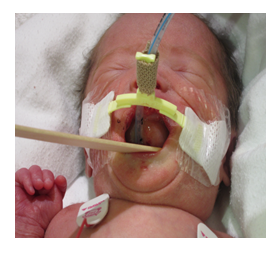
Figure 1: Appearance at birth.
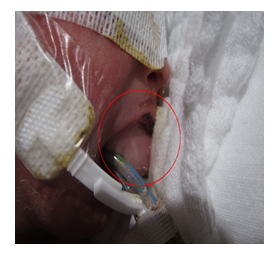
Figure 2: The tumor on day 3 after delivery.
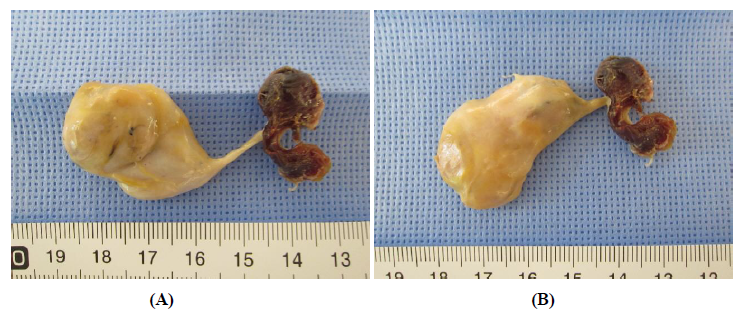
Figure 3: (A) The appearance of the tumor on day 7 after delivery. (B) lateral view.
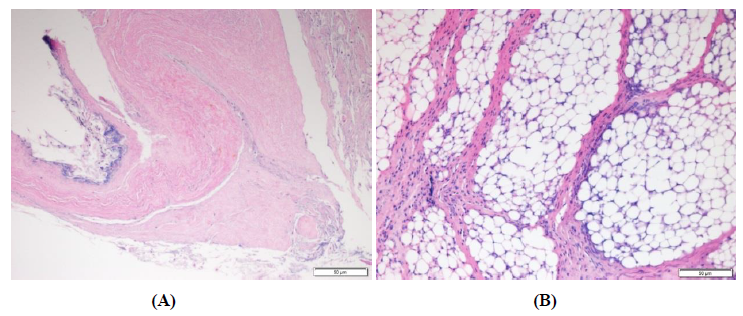
Figure 4: (A) H-E stain x40 Stratified squamous epithelium and hair follicles. (B) H-E stain x100 fat tissue.
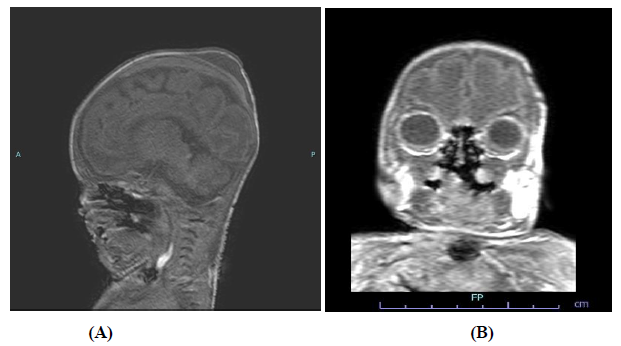
Figure 5: (A)MRI findings before operation sagittal view. (B) frontal view.
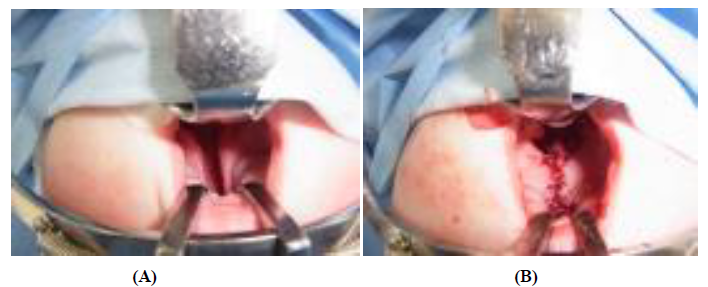
Figure 6: (A) cleft palate before operation. (B) view of after Furlow procedure.
3. Discussion
The occurrence of teratoma in the oral cavity, and particularly on the hard palate is relatively rare. Only 23 cases have been reported in the English medical literature (Table 1) [1-21]. Other sites where teratomas are found include the posterior nasopharynx, upper lip and nose, soft palate, and tonsil. Pathologically, there are four types of teratomas: dermoid cyst, teratoid cyst, true teratoma, and an epignathus as described by Arnold in 1870 [22]. A dermoid cyst is lined by epithelial element composed of ectodermal and mesodermal cells. Teratoid cysts are composed of all three germ layers but are poorly differentiated, while true teratomas consist of three well-differentiated germlayers. Lastly an epignathus is an oral tumor with developmental fetal organs and limbs. Our case was diagnosed as a true teratoma, which consisted of a mature squamous cell layer, fatty tissue, and hair-like parts with a lot of melanin staining, and most of these layers were necrotic. A cleft palate is the malformation most associated with teratoma’s with an incidence of 6-20% [15, 23]. This indicates the possibility that the cause is of the cleft is mechanical obstruction caused by the tumor preventing closure of the palatal shelves. Other accompanying malformations are cardiac deformities such as atrial and ventricular septal defects. We found 21 reports that detailed 23 cases of neonatal teratomas arising from the hard palate that were combined with a cleft palate (Table1) [1-21]. Jadhav [24] reported that teratomas occur in females more than in males with a ratio of 3:1, but in cases where the tumor originated in the hard palate, the ratio was 14:9. There is one report that described this condition in twins.
|
Case |
Gender |
Size(cm) |
Ultrasound before delivery |
Histopathology |
|
Strachen(1930) |
Female |
9.5 × 8 |
no sign |
Cartilage, muscle lymphoid |
|
Bennet(1970) |
Male |
? |
no sign |
Teratoma(three germinal layers) |
|
Wilson &Gehweiler(1970) |
Female |
20 × 18 |
- |
Teratoma (neural elements, muscle, cartilage, hair, bone) |
|
Hatzihaberies(1978) |
Male |
38w |
Mature teratoma (three germinal layers) |
|
|
Kaplan(1980) |
Male |
10 × 8 × 5, 790 g |
27w |
Mature teratoma (neural, cartilage, bone) |
|
Chavenak(1984) |
Female |
9.2 × 7.9 12 × 10 |
32 36 |
Immature teratoma |
|
Zakaria(1986) |
Female |
? |
- |
Teratoma(three germinal layers |
|
Ang(1990) |
Male |
7.3 |
35w |
immature teratoma |
|
Levine(1990) |
Female |
4.6 × 8.4 × 11.3 |
36w(normal until17w) |
Teratoma(varying degree of differentiation) |
|
Smith(1993) |
Female Female |
4 2 |
29w 18w |
Immature glial tissue, central vertebra-like bodies.Neural, cartilage, smooth and skeletal muscle,ciliated gladulae epithelium |
|
Ekici(1996) |
Male |
9 × 11 × 13 |
23w+ |
Benign teratoma |
|
Wakhlu(2000) |
Male |
2 × 2 |
- |
Mature teratoma |
|
Cay(2004) |
Male |
6 × 4 |
- |
mature teratoma (neural,squamous epithelium adipose tissue bone) |
|
Lionel(2004) |
Female |
11 × 6.7 × 9.7 |
32w |
Benign teratoma(three germinal layers) |
|
Noguchi(2005) |
Female |
? |
- |
Hamartoma of tongue |
|
Halterman(2006) |
Male |
12 × 6 × 5 |
28w |
Benign teratoma(three germinal layers) |
|
Jie He(2010) |
Male Female |
4 2.5 |
unremarkable no sign |
Benign teratoma Benign teratoma |
|
Mirshemirani (2010) |
Female |
6 × 4 × 3 |
normal |
Mature teratoma(adipose tissue tooth mucin secreting glands neural skeletal muscle ) |
|
Chanhan(2011) |
Female |
20 × 16 × 8 |
- |
Benign teratoma(three germinal layers) |
|
Kandukuri(2016) |
Female |
17 × 11 × 6 |
No Sign at 8 weeks |
Teratoma (Three germinal layers) |
|
Veyssiere(2016) |
Female |
1.7 × 1.5 × 3.8 |
no sign |
Benign mature teratoma |
|
Our case(2020) |
Female |
5 × 2 |
no sign |
Mature teratoma |
Table 1: Congenital teratomas.
Since 1970, pregnant women undergo regular prenatal ultrasound screening from about 12 weeks gestation. in addition, since 2000s, standardization of fetal measurements is recommended, and highly accurate early fetal screening became available. Only 8 out of the 23 cases detected a mass in the prenatal period. Levine [9] reported that a sonograph that was performed at 17 weeks did not show any masses, but after birth, a 4.6 cm × 8.4 cm × 11.3 cm sized mass was found. In addition, Smith [10] reported that screening performed at 9 weeks did not detect any abnormalities, but then at 29 weeks he found a 4cm mass, and in another case he found a The other case he found 2 cm mass at 18 weeks gestation. The size of the detected tumor was not significantly different at the average of 8.75 cm an average of 8.4 cm. Smith [10] explained he could detect the 2 cm mass at only 18th weeks gestation, so it depends on the each sonography technique whether the mass will be detected or not. However, as a result of significant developments in ultrasonography, most technicians can detect masses that are larger than 9 cm size. Chervenak [6] explained that they recognized the size of tumor was 9.2 cm × 7.9 cm at 32 weeks gestation, and it had become 12 cm × 10 cm at 36 weeks. Because we do not know the growth rate of the mass, we should observe the growth carefully, in order to prepare for the respiratory problems, because most difficult complications are related to air-way obstruction in neonates. Ultrasounds at 15-17 weeks usually detect the abnormality if the fetus had a big mass in the oral cavity. In our case, she was a twin, which made it more challenging to discover the mass. The severity of respiratory distress correlates with the size of the teratoma. Kontopoulos [24] reported on the successful intrauterine treatment of an oral teratoma using YAG laser, and after surgery, the baby was born without any complications. To prevent respiratory problems after birth, intrauterine surgery is considered as an important treatment modality.
In our case the mass was not detected prenatally, so intrauterine operation was not considered. Although the mass grew daily after birth. it eventually spontaneously necrosed and fell off, as reported in other cases. Recurrence is the most common complication in cases like our case. April [25] reported that inadequate resection of the tumor causes recurrence, and this complication is detected by asymmetric elevation of serum AFP levels. Although the rate of recurrence is low, if it identified, complete excision is recommended. Furthermore, in the case of malignant teratomas, radiotherapy and chemotherapy are administrated after complete extirpation of the tumor [13], and regular examination of the hard palate and AFP level are recommended after this treatment.
4. Conclusion
We presented the case of a1372 g female neonate who was delivered with a congenital teratoma that originated from the hard palate, which was associated with a cleft palate. The tumor spontaneously fell off. Because the most anticipated complication important consumption was recurrence, careful inspection and follow-up of the patient was required.
Ackowledgement
We would like to thank Editage (www. editage. com) for English language editing.
References
- Strachan GI. Epignathus:a rare case foetal monstrosity. J Obstet Gynaecol Br Emp 37 (1930): 577-581.
- Benntt JP. A case of epigunathus with long term survival. Br J Plast Surg Surg (1970): 360-364.
- Wilson J, Gehweiler J. Teratoma of the face associated with a patent canal extending into the cranial cavity(Rathke’s pouch)in a three-week-old child. JPediatr Surg 5 (1970): 349-359.
- Hatzihaberis F, Stamatis D, Staurions D. Giant Epignathus. J Pediatr Surg 13 (1978): 517-518.
- Kaplan C. Perlmutter S. Molinoff S. Epignathus with placental hydrops. Arch Pathol Lab Med 104 (1980): 374-375.
- Chervenak FA, Tortora M, Moya FR, et al. Antenatal sonographic diagnosis of epigunathus. J Ultrasound Med 3 (1984): 235-237.
- Zakaria MA. Epignathus(congenital teratoma of the hard palate): A case report. Br J Oral Maxillofac Sur 24 (1986): 272-276.
- Ang AT, Ho NK, Ong CL. Giant epignathus with intracranial teratoma in a newborn infant. Australas Radiol 34 (1990): 358-360.
- Levine AB, Alvarez M, Wedgewood J, et al. Contemporary Management of A Potentially Lethal Fetal Anomaly. Obstetrius & Gynecology 76 (1990): 962-967.
- Smith NM, Chambers SE, Billson VR, et al. Oral teratoma(epignathus)with intracranial extension:areport of two cases. Prenat Diagn 13 (1993): 945-952.
- Ekici E, Soysal M, Kara S, et al. Prenatal diagnosis of epignathus causing acute polyhydramnios. Acta Obstet Gynecol Scand 75 (1995): 498-501.
- Wakhlu A, Wakhlu AK. Head and neck teratoma in children. Pediatr Surg Int 16 (2000): 333-337.
- Cay A, Bektas D, Imamohlu M. Oral teratoma:a case report and literature review. Pediatr Surg Int 20 (2004): 304-308.
- Lionel J, Valvoda M, Hadi K. Giant epigunathus-A case report. Kuwait J. 36 (2004): 217-220.
- Noguchi T, Jinbu Y, Itoh H, et al. Epigunathus combined with cleft palate, lobulated tongue, and lingual hamartoma: Report of a case. Oral Surgery, Oral Medicine, Oral Pathology, Oral Radiology, and Endodontology 101(2006): 481-486.
- Halterman SM, Igulada KN, Stelnicki EJ. Epigunathus:Large obstructive teratoma arising from the palate. The cleft palate-craniofacial J 43 (2006): 244-246.
- Jie He, Wang Y, Zhu H, et al. Nasopharyngeal teratoma associated with cleft palate in newborn:report of 2 cases. Oral surg oral med oralpathol oralradiol endod 109 (2010): 211-216.
- Mirshemirani A, Khaleghnejad A, Mohajerzadeh L, et al. Congenital nasopharyngeal teratoma in a neonate. Iran J Pediatr 21 (2011): 249-252.
- Chanhaw DS, Guruprasad Y, Inderchand S. Congenital nasopharyngeal teratoma with a cleft palate:case report and a 7 year follow up. J. Maxillofac. Oral Surg 10 (2011): 253-256.
- Kumar KM, Veligandla I, Lakshmi A, et al. Congenital giant teratoma arising from the hard palate:A rareclinical presentation. J Clinic&Diagnotic Research 10 (2016): 3-4.
- Veyssiere A, Streit L, Traore H, Benateau H. Cleft palate caused by congenital teratoma. Paediatr Int Child Health 37 (2017): 66-69.
- Arnold J. Uber behaarte polypen der rachenmundhole und derren stellung zu den teratomen. Virchow’s Arch 3 (1888): 176-210.
- Kontopoulos E, Gualtieri M, Quintero R. Successful in utero treatment of an oral teratoma via operative fetoscopy :case report and review of the literature. Am J Obstet Gynecol 207 (2012): e12-e15.
- Jadhav SS, Korday CS, Malik S, et al. Epignathus leading to fatal airway obstruction in a neonate. J Clinc& Diag Research 11 (2017): 4-5.
- April MM, Ward RF, Garelick J. Diagnosis, Management, and Follow-up of Congenital Head and Neck Teratomas. The Laryngoscope 108 (1998): 1398-1401.


 Impact Factor: * 5.3
Impact Factor: * 5.3 Acceptance Rate: 75.63%
Acceptance Rate: 75.63%  Time to first decision: 10.4 days
Time to first decision: 10.4 days  Time from article received to acceptance: 2-3 weeks
Time from article received to acceptance: 2-3 weeks 
